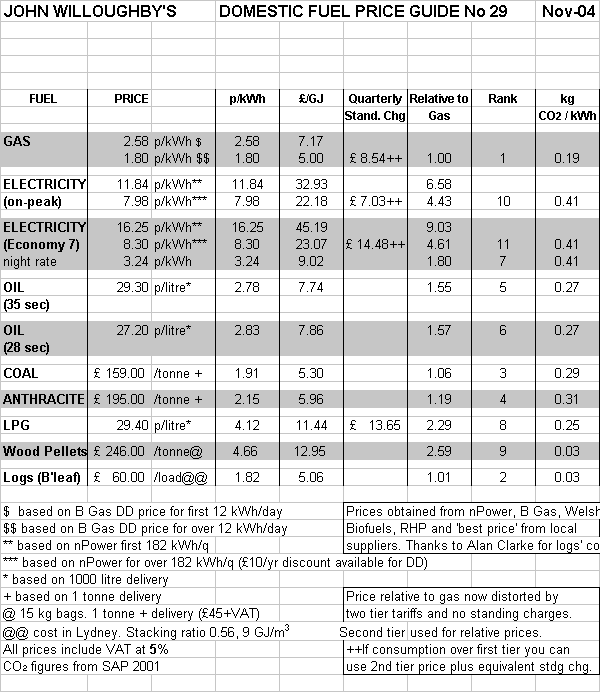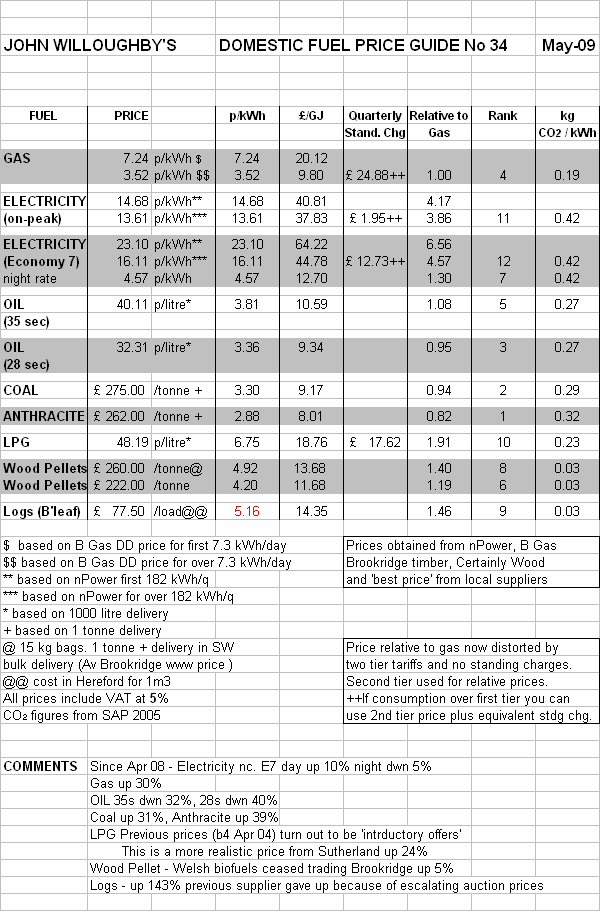We’d like to remind Forumites to please avoid political debate on the Forum.
This is to keep it a safe and useful space for MoneySaving discussions. Threads that are – or become – political in nature may be removed in line with the Forum’s rules. Thank you for your understanding.
📨 Have you signed up to the Forum's new Email Digest yet? Get a selection of trending threads sent straight to your inbox daily, weekly or monthly!
My solar PV first year payback calculation
Comments
-
The 36.5p is included as a fixed number ( as it won't change), and just multiplies your generated units by 36.5p. Thanks
All other numbers quoted by other people are either in the spreadsheet, or are easy to change variables
Well I used your assumptions except I used the cost as £7,500 which is more realistic.
Using that data, by my back of a fag packet calculations, you will never get a ROI inside 20 years
The £7500 invested compound at 4% nett will be worth £11,100 after 10 years and £16,430 after 20 years.
Your big savings will be the 1,186kWh @ 36.5p invested at 4%. This after 10 years will have grown to £5,383 and after 20 years to £12,826
your 10p per kWh for 1,186kWh (£118.60 in year 1) inflated at 5% and earning interest at 4% will save you approx £2000 in 10 years and £5000 in 20 years(can't be bothered to work it out accurately)
Assuming your figure of £50 pa for maintenance - I haven't bothered to inflate this figure or add 4% interest compounded - that is a simple £500 over 10 years and £1,000 over 20 years.
So after 10 years you will be 'losing*' by approx £4,200 and after 20 years you will be about even.
* losing defined by invested monies.
The panels by then will be at the end of their useful life, which is what I assume you suggest by asset loss of 5%??
As said in an earlier post you can make all kinds of different assumptions, but even the most pro-solar advocate surely could not argue that it will take much less than 20 years to break even??
Comments?0 -
Well I used your assumptions except I used the cost as £7,500 which is more realistic.
Nothing is more realistic than the actual, which was £5450 (plus £120 finance fee) - please could you recalculate using this? £2,000 is a great deal of money to ignore.
I actually agree with most of your calculations, so this should be interesting
Thanks0 -
Nothing is more realistic than the actual, which was £5450 (plus £120 finance fee) - please could you recalculate using this? £2,000 is a great deal of money to ignore.
I actually agree with most of your calculations, so this should be interesting
Thanks
I would estimate with the large subsidy you received it will be about 15 years to break even.
There is no point in doing it accurately as most of the figures are assumptions and can be validly queried. i.e.
Will there be any subsidy when feed in tariffs come into play?
Will fuel inflation be higher/lower than a 5% average.
Will interest rates be higher/lower than 4%
What will be the cost of maintenance? If the system is so reliable - why only a 2 year guarantee?
Will panels require cleaning? most people say yes, which on the roof will cost if DIY not possible. You living in N Wales with high rainfall might get them washed clean. I have velux windows in an extension and they certainly need cleaning.
The output from PV varies greatly according to the latitude in UK. Cornwall being about 30% higher than the Scottish Highlands.
Being a self confessed solar-sceptic I would doubt that in future anyone will get payback during the useful life of the system. To support that hunch(no more than that) I would submit.
Many people will have to borrow installation costs at a lot more than 4%.
I believe that better returns than a 4% average are possible(invest in a solar company;))
I think the electronics, cables etc will require repair and cost a lot.
Cleaning!
I cannot see successive Governments allowing unlimited feed-in tariff rates of 36.5p. It is likely in the next few years that cheaper high performance Panels will be available and I suspect the Government will restrict the level of units for which they will pay a 36.5p feed-in tariff.
One thing is certain.
The cowboys who mis-sold solar hot water with unbelievable claims of savings will turn their attention to Solar electricity!0 -
Quite a change (a very welcome change!) from your 50 year estimate in post 18!I would estimate with the large subsidy you received it will be about 15 years to break even.
I hope so! It makes my payback quicker!:DI believe that better returns than a 4% average are possible!
I, like others here, researched PV before purchasing, and was not coerced by any cowboys. I would certainly recommend people researching it throughly using whichever method they want.The cowboys who mis-sold solar hot water with unbelievable claims of savings will turn their attention to Solar electricity!
Cardew - I'd like to thank you for your slight shift in pessimism. You rightly say, we cannot predict the future, but using conservative guesses, have produced an acceptable payback for the panels (15 years IMO is acceptable, though I calculate it slightly lower).0 -
"I believe that better returns than a 4% average are possible!"
I hope so! It makes my payback quicker!:D
Not so!
Don't forget that the capital sum(£7,500 or £5450) starts getting the extra interest straight away on that sum. So for illustrative purposes if you used 10% you would get £750 interest in the first year. £825 in second year
The feed-in tariff and 10p/kwh savings would get very little interest in the first year, about £30, and £120 in the second year.
So the gap gets much wider and payback much longer - 30/40 years.
Conversely if interest rates dropped to zero then payback time would be about 16 years. (for £7500)
I have used 20 years as an illustration, in practice I suspect very few people will ever see a return on their investment.0 -
cardew, so far so good, but what figure are you using for pence per kW rise year on year.....if you only calc at 2% rise per year on 10p/kWh its goes up to 12.19p/kwh after 10 years and 14.85p/kWh after 20 years...on 3300 units (UK average) that is £402.27 and £490.05 respectively. at 4% inflation it would be 14.25p......or at 7%.....19.67p.......£470.25 and £649.11.....if my dumb maths are right...... by the way I have not included the tier 1 part ( first 125kW/quarter at 23p........at 2% 4% 7%, )
I stand to be corrected as is my signatureThere are three types of people in this world...those that can count ...and those that can't!
* The Bitterness of Low Quality is Long Remembered after the Sweetness of Low Price is Forgotten!0 -
cardew, so far so good, but what figure are you using for pence per kW rise year on year.....if you only calc at 2% rise per year on 10p/kWh its goes up to 12.19p/kwh after 10 years and 14.85p/kWh after 20 years...on 3300 units (UK average) that is £402.27 and £490.05 respectively. at 4% inflation it would be 14.25p......or at 7%.....19.67p.......£470.25 and £649.11.....if my dumb maths are right...... by the way I have not included the tier 1 part ( first 125kW/quarter at 23p........at 2% 4% 7%, )
I stand to be corrected as is my signature
As I said in post #74 I used mcfi5's suggested fuel inflation figure of 5%.your 10p per kWh for 1,186kWh (£118.60 in year 1) inflated at 5% and earning interest at 4% will save you approx £2000 in 10 years and £5000 in 20 years(can't be bothered to work it out accurately)
i.e.Take the saving of £118.60 in year 1 and add 4% interest. To that total add (£118.60 x 1.05) etc etc
It is irrelevant if you use 3,300kWh per year or 50,000kWh per year as your only saving will be on the 1,186kWh generated by solar.
i.e. If you use 3,300 per year and have solar, you pay for 2,114 kWh at whatever the going rate and get 1,186 kWh free.
Without solar you pay for 3,300 kWh at whatever the going rate.
So the only calculation for ROI that matters is the 5% inflation linked savings on 1,186 kWh plus the interest those savings accrue @ 4%.
Incidentally I have assumed that you use all the 1,186kWh you generate. In practice you will not use it all and will thus sell them to your supplier and they I understand certainly will not give you 10p/kWh inflated @5%. In fact I have read the figure currently is 5p. That will have the effect of reducing the generous estimate of £200 and £5000 I gave.0 -
this is what we were paying in November 2004 5yrs ago
 There are three types of people in this world...those that can count ...and those that can't!
There are three types of people in this world...those that can count ...and those that can't!
* The Bitterness of Low Quality is Long Remembered after the Sweetness of Low Price is Forgotten!0 -
And this year....
 There are three types of people in this world...those that can count ...and those that can't!
There are three types of people in this world...those that can count ...and those that can't!
* The Bitterness of Low Quality is Long Remembered after the Sweetness of Low Price is Forgotten!0 -
just so everyone can see, just take the gas for instance, it has jumped from 2.58p/kW to 7.24p/kW...a 180% increase in 5 years!! surely you have to factor this type of increase in fuel costs..... makes interesting reading doesn't it. are we likely to ever get 180% interest from the banks......There are three types of people in this world...those that can count ...and those that can't!

* The Bitterness of Low Quality is Long Remembered after the Sweetness of Low Price is Forgotten!0
This discussion has been closed.
Confirm your email address to Create Threads and Reply

Categories
- All Categories
- 352.9K Banking & Borrowing
- 253.9K Reduce Debt & Boost Income
- 454.7K Spending & Discounts
- 246K Work, Benefits & Business
- 602K Mortgages, Homes & Bills
- 177.8K Life & Family
- 259.9K Travel & Transport
- 1.5M Hobbies & Leisure
- 16K Discuss & Feedback
- 37.7K Read-Only Boards


